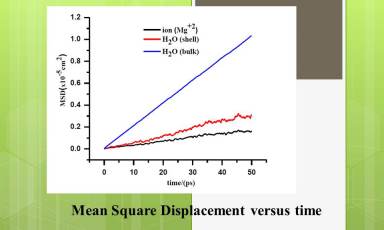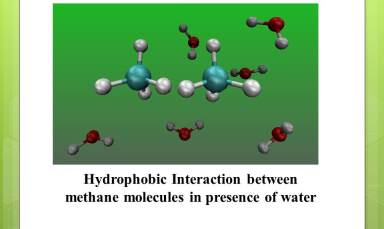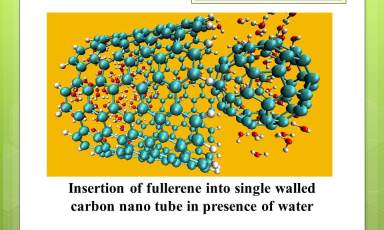a) Liquid state theory, solvation dynamics and charge transfer
The current techniques of statistical mechanics, such as the integral equation methods, perturbation theories and the molecular dynamics and the Monte Carlo simulation methods are being used to study the interparticle distributions in molecular liquids. The reactants considered for the charge transfer process are the ferrous and ferric ions. The response of the solvents such as water, DMSO, or a model dipolar solvent to a charge transfer is studied through the time-correlation functions of the solvent forces and fields. The information on the solvent relaxation in polar solvents, the work terms to bring the reactants together in a condensed medium and the local rate constants between the reactants at various interparticle separations are used to develop a rate theory of electron transfer in polar solvents. This are used to rationalise the behaviour of activation entropies and activation volumes in the kinetics of charge transfer reactions in solution.
b) Physical chemistry at surfaces and interfaces
The thermodynamic behaviour of systems such as (a) gas atoms adsorbed on solid surfaces and (b) monolayers of fatty acid mixtures at the air/water interface is studied by using the statistical mechanical perturbation theory. The concept of an effective diameter of a fatty acid molecule on the interface is developed and used to predict the pressure-area isotherms of fatty acid mixtures.
c) Stabilities of intermediates and reactive pathways in solution medium
Several reactions (such as the solvolysis of the exo and the endo norbornyl derivatives) are known wherein the rate for one kind of a reactant is orders of magnitude larger than the rate for another kind of a closely realted reactant. Through the molecular dynamics simulations of reactants and the intermediates in suitable model solvents, the information on the energetics of the various reactive pathways in a solution environment is being computed. This approach will yield quantitative information on the steric effects in reactions in the solution medium.
d) Mechanism of superionic conduction
Crystalline solids such as lithium sulphate, calcium fluoride and silver iodide show liquid-like conductivities (superionic conductivities) of one of the constituent ions well below their melting point. Through molecular dynamics simulations, we are investigating the nature of the ion transport in the regime of superionic conductivity. In the lithium sulphate lattice, the lithium ions seem to diffuse without making use of the octahedral holes of the sulphate sublattice and the effect of the rotational motion of the sulphates also seems to be of minor importance. The simulations are also being used to estimate the magnitudes of the activation barriers to the diffusive motions.
e) Electron thermalization in gases
The transfer of the excess energy of electrons into the various modes of gaseous quenchers is studied through the solution of the Boltzmann transport equation. The inputs needed are the experimental cross sections for the transfer of translational, rotational and vibrational energies to the molecules, and an iterative scheme to solve the transport equation. This is done by assuming a pseudo-Maxwellian form for the distribution function of the electron energies which graually decays to its equilibrium form as the electrons thermalize.
f) Ion pairs in solvents
The formation of + +, + - and - - ion pairs in pure solvents and solvent mixtures is investigated by computing the potentials of mean force (PMF) between the ions in solution. The nature of the PMF is probed by studying the dynamical ion pair trajectories as well as the structure of the solvent around the ion pair at various interionic separations. In the case of sodium chloride ion pair water, both the contact ion pair and the solvent separated ion pairs are equally stable. In DMSO, the sodium chloride ion pair exists predominantly as a contact ion pair. In water-DMSO mixtures however, the contact ion pair is not found even up to 90% mole fraction of DMSO.



